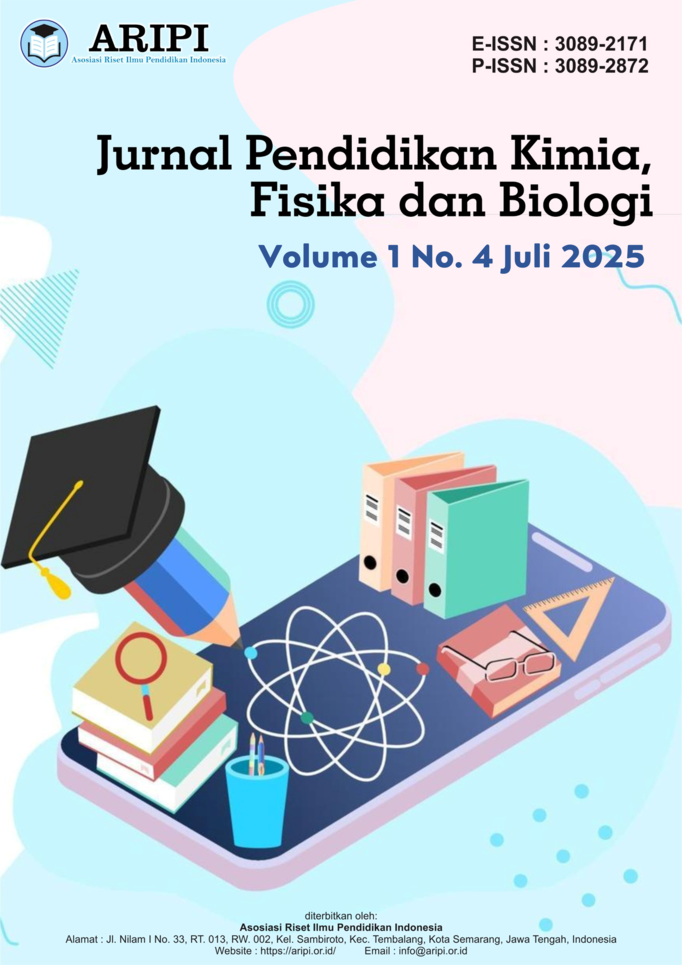Adsorpsi Ion Logam Cr (VI) dari Adsorben Karbon Aktif Tongkol Jagung (Zea Mays)
DOI:
https://doi.org/10.61132/jupenkifb.v2i4.323Keywords:
Adsorption, Corn Cob, Aktivated Carbon, Cr(VI), pH, Contact TimeAbstract
The use of Cr (Chromium) in industry and daily life produces toxic waste harmful to humans and the environment. This study aims to evaluate the effectiveness of activated carbon from corn cobs as an adsorbent for Cr(VI) heavy metal. Corn cobs, which contain 40–44% cellulose, were carbonized at 500°C using 6% sodium carbonate and characterized with an IR spectrophotometer. Adsorption tests were conducted by varying pH and contact time to determine optimal conditions. FTIR results revealed functional groups such as C≡C stretch, C=C=C stretch, and C–O bend. After activation, O–H groups appeared, indicating the presence of aromatic compounds, which are typical in activated carbon. The optimum pH for Cr(VI) adsorption was pH 4, with an adsorption rate of 65.35%. The optimum contact time was 60 minutes, resulting in 3.2% Cr(VI) adsorbed and a maximum adsorption capacity of 0.089 mg/g. In conclusion, corn cobs are a promising, eco-friendly, and effective natural material for adsorbing Cr(VI) heavy metal ions.
References
Adebayo, G. B., Adegoke, H. I., & Fauzeeyat, S. (2020). Adsorption of Cr(VI) ions onto goethite, activated carbon and their composite: kinetic and thermodynamic studies. Applied Water Science, 10(9), 1–18. https://doi.org/10.1007/s13201-020-01295-z
Aini, R. (2021). Ekstraksi dan Karakterisasi Selulosa dari Kulit Buah Aren ( Arenga pinnata ) Untuk Penyerapan Ion Logam Cr(VI). Vi, 1–75.
Erlina, dkk. 2015. Pengaruh Konsentrasi Larutan KOH Pada Karbon Aktif Tempurung Kelapa Untuk Adsorpsi Logam Cu. Jurnal Fisika, Vol 4 (55). http://snf-unj.ac.id/kumpulan-prosiding/snf2015/
Kurniawan, A., & Purnama, M. (2018). Pemanfaatan silika gel dari limbah sekam padi sebagai adsorben ion logam Pb(II). Jurnal Sains dan Teknologi Lingkungan, 10(1), 35–42. https://doi.org/10.14710/jstl.10.1.35-42
Leni, dkk. 2015. Pemanfaatan Kulit Singkong Sebagai Bahan Baku Karbon Aktif. Jurnal Tekonologi Kimia Unimal, Vol 4 : 2 (11-19). http://ft.unimal.ic.id/teknik_kimia/jurnal
Meilianti, M. 2020. Pembuatan Karbon Aktif dari Arang Tongkol Jagung dengan Variasi Konsentrasi Aktivator Natrium Karbonat (Na2CO3). Jurnal Distilasi, 5(1), 14. https://doi.org/10.32502/jd.v5i1.3025
Rokhati, N., Prasetyaningrum, A., Hamada, N. Aini, Utomo, A. L. C., Kurniawan, H. B., & Nugroho, I. H. 2021. Pemanfaatan Tongkol Jagung Sebagai Adsorben Limbah Logam Berat. Jurnal Inovasi Teknik Kimia, 6(2), 89. https://doi.org/10.31942/inteka.v6i2.5508
Setiawan, R., & Pratama, G. (2020). Adsorpsi ion logam Cd(II) dari limbah cair elektroplating menggunakan karbon aktif dari limbah ampas tebu. Jurnal Rekayasa Kimia & Lingkungan, 15(3), 120–126. https://doi.org/10.23955/rkl.v15i3.16638
Sugiharto, A., Hoyali, I., Ghifari, A. F. A., & Nabilla, T. H. (2020). Effect of Contact Time of Rice Husk Ash and Poly Aluminum Chloride to Reduce the Concentration of Rhodamin B Dyes Using the Adsorption-Fluidization Method. CHEMICA: Jurnal Teknik Kimia, 7(1), 77. https://doi.org/10.26555/chemica.v7i1.16529
Windiastuti, R. T., & Santoso, T. 2011. Determination of Optimum pH and Contact Time from the Adsorption Process of Cu(II) Ions by Corn Cob (Zea mays) Biomass. Jurnal Akademika Kimia, 9(4), 224229. https://doi.org/10.22487/j24775185.2020.v9.i4.pp224-229
Yuliasih, I., & Mustika, R. (2019). Adsorpsi logam berat Cr(VI) menggunakan komposit kitosan-silika hasil ekstraksi dari limbah kaca. Jurnal Kimia Valensi, 5(2), 117–124. https://doi.org/10.15408/jkv.v5i2.11360
Downloads
Published
How to Cite
Issue
Section
License
Copyright (c) 2025 Jurnal Pendidikan Kimia, Fisika dan Biologi

This work is licensed under a Creative Commons Attribution-ShareAlike 4.0 International License.





